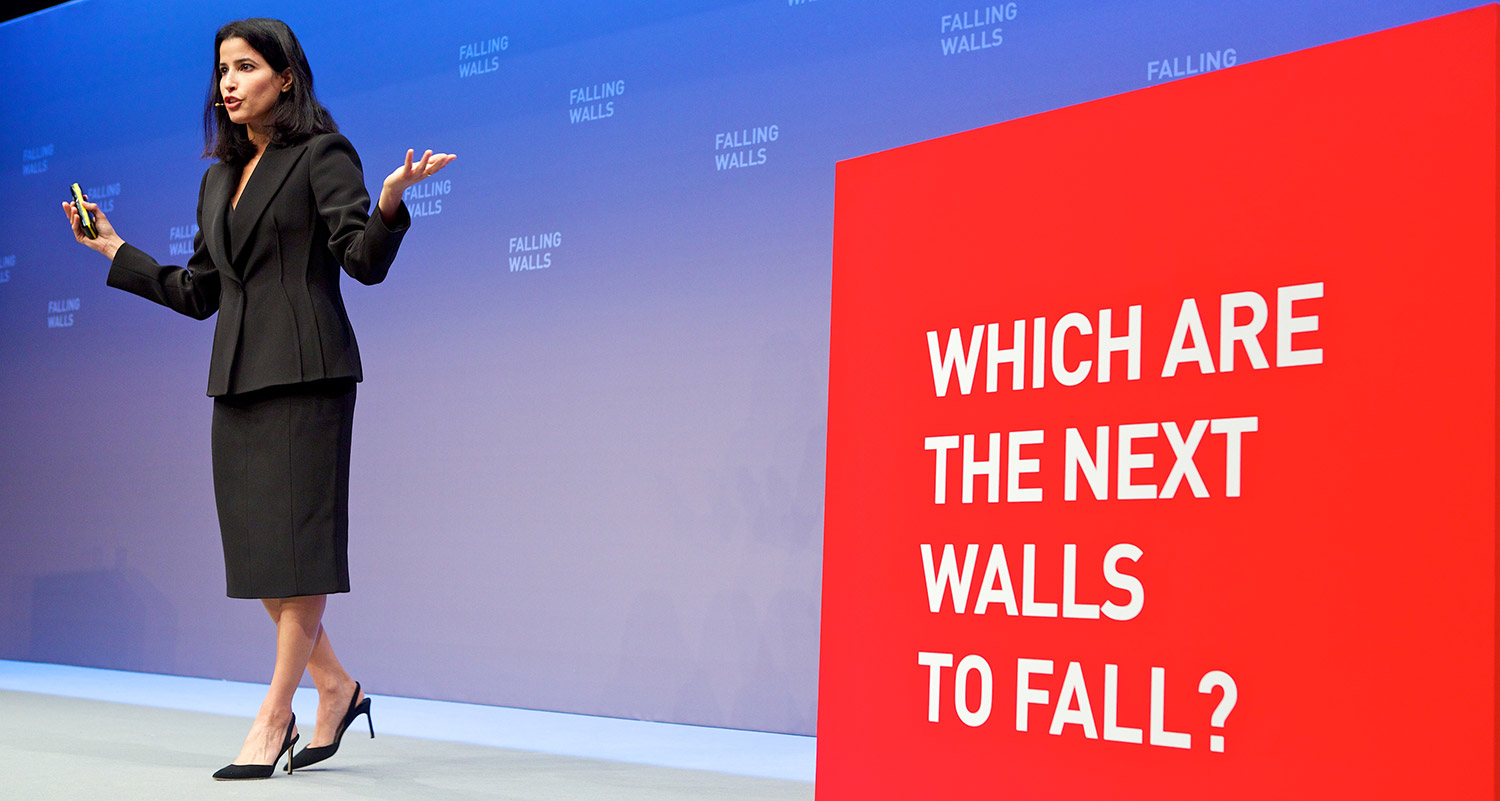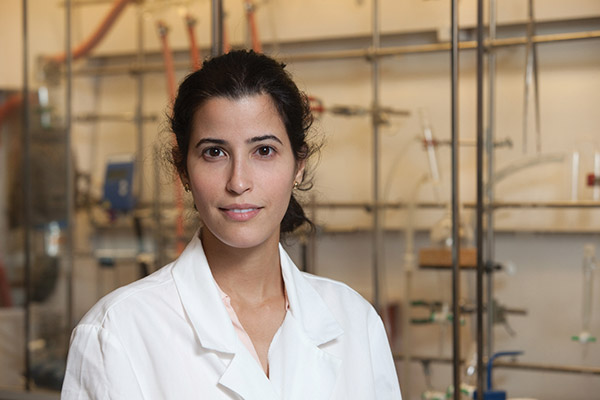
By:
- Heather Buschman
Published Date
By:
- Heather Buschman
Share This:

Adah Almutairi Breaks Down Barriers at Berlin’s “Falling Walls” Conference
Adah Almutairi is a polymer chemist. But if you give her a blank look at the mere mention of “polymers,” she might quickly change that to say she’s a “construction worker… on the nano scale” or a “plastics chemist,” the term she used to introduce herself at the recent Falling Walls conference in Berlin.
Falling Walls is an annual, one-day conference showcasing scientific research from around the world. It coincides with the anniversary of the fall of the Berlin Wall.

Adah Almutairi
The event, which aims to reduce barriers to major global challenges, was an obvious fit for Almutairi, who could also be introduced simply as “problem solver.” When Almutairi encounters a difficulty, even in her personal life, she immediately begins thinking of ways to fix it — whether it’s a few extra pounds post-baby or annoying plastic braces.
On this first issue, Almutairi is now working with her brother, a plastic surgeon, and the FDA to develop human clinical trials for a better way to perform liposuction. Their method involves the injection of gold particles, which are then heated to help melt the fat and remove it with less trauma to other tissues. As for her second problem, Almutairi is taking some ideas on ultrasound pulsing to her orthodontist, with the thought that there must be an easier and faster way to get teeth to move.
But Almutairi’s large bioresponsive materials lab in the UC San Diego Skaggs School of Pharmacy and Pharmaceutical Sciences is probably best known for designing and developing smart polymers, nanoparticles and hydrogels for many innovative medical and research applications.
In one hot project she highlighted at Falling Walls, Almutairi’s team is using light stimulation to direct drug-delivering nanoparticles in living systems. With this approach, nanoparticles are told exactly when and where to drop their therapeutic payloads — assuring that they will do the most good against disease and the least harm to healthy tissues.
Here’s how Almutairi’s clever drug delivery technique works. First, nanoparticles carrying therapeutic drugs are introduced into a living system. Then, an external low-power laser is used to heat pockets of water trapped within the nanoparticles. The heat softens the nanoparticle, releasing its drug contents into the surrounding tissue. The best part of this method is the precise control the user has over how much and where the drug is dispersed, and the heat-and-release process can even be repeated as needed.
Changing minds
From early in her career, Almutairi had always wanted to take a project all the way from building the molecule to seeing it work in humans. But her ideas weren’t always so well received. Just seven years ago, before she joined the faculty at UC San Diego, colleagues in Almutairi’s field would often shrug after she gave talks about her work — “that’s elegant chemistry,” they’d say. “But there will never be useful, human applications for this sort of thing.”
Today, Almutairi is proud to say that she’s changing minds.
The liposuction work is shaping up to be her first experience bringing chemistry to the clinic. “Like I tell my lab, while liposuction isn’t exactly saving lives, it’s our first test case. It’s going to help us learn how to move many other projects that do from the lab and into human trials,” Almutairi says.
And for many of the varied projects in Almutairi’s lab — touching on everything from diabetes to MRI imaging — there’s great interest from pharmaceutical, cosmetic, chemical and energy companies all over the world. Dow, Merck, L'Oréal, biologists and engineers alike… everyone, it seems, now sees exciting applications for Almutairi’s work.
The next big thing
But of all this success, what Almutairi focused on most at Falling Walls, what she’s most excited about, is the next big thing. For her, that’s lanthanides.
“Even though I have no business studying lanthanides — it’s not a polymer!” she says with a laugh. But, she says, merging fields is what creates innovation. That’s why when Almutairi first came to UC San Diego, she was looking forward to exploring new areas that might intersect with her own interests. Lanthanides was one of them.
Lanthanides are chemicals classified as “rare earth elements.” Which is a bit of a misnomer, Almutairi says. “Lanthanides aren’t rare; they’re actually very abundant — more abundant than gold, and cheaper.”
Lanthanides intrigued 19th century chemists — among many other interesting properties, they burn easily in air, fluoresce under UV light and react with most nonmetals. But then lanthanides inexplicably fell out of popularity in the 1970s. Now Almutairi is taking up the mantle to explore how lanthanides do one special thing: convert low-energy light to high-energy light. She has two people in her lab, a postdoctoral researcher and a graduate student, looking for ways to take advantage of that property and apply it to the medical and engineering fields.
“This light conversion process is fragile,” Almutairi explained at Falling Walls. “Photons fall off lanthanides easily, as heat. So we created a protective shell to contain the process. Now, we’re using this to help shape the landscape in solar energy harvesting and solar desalination.”
And, if Almutairi’s other projects are any indication, solar energy and desalination won’t be the end of the story. People will likely come knocking on her door with an imaginative array of possible uses that she hasn’t even dreamed of yet.
As Almutairi said at Falling Walls, “We want to give these tools to biologists and see all the ways they find to use it. Inventors are often surprised by the application of their own work.”
To watch the video of Almutairi’s Falling Walls talk about light-activated nanoparticles and lanthanides, visit falling-walls.com
Share This:
You May Also Like
Stay in the Know
Keep up with all the latest from UC San Diego. Subscribe to the newsletter today.


